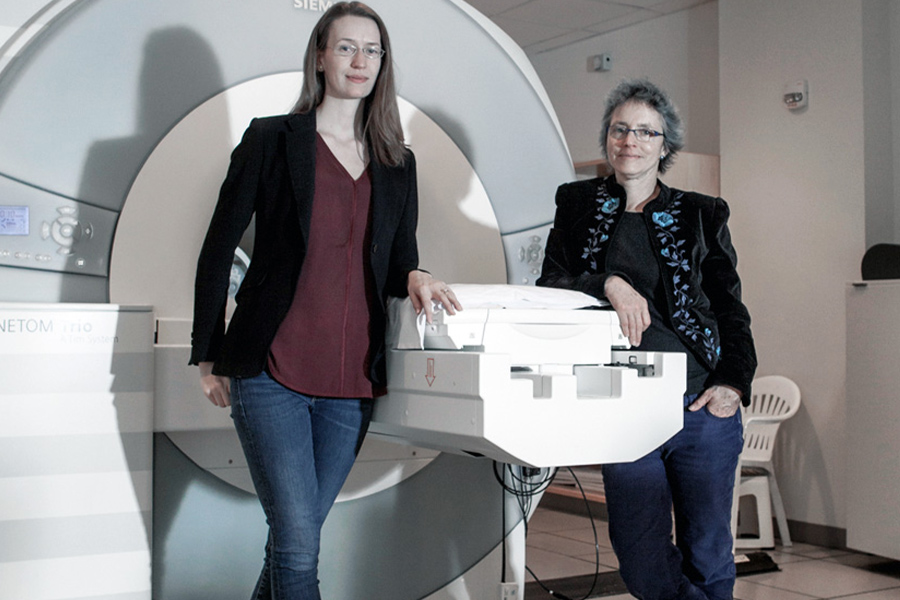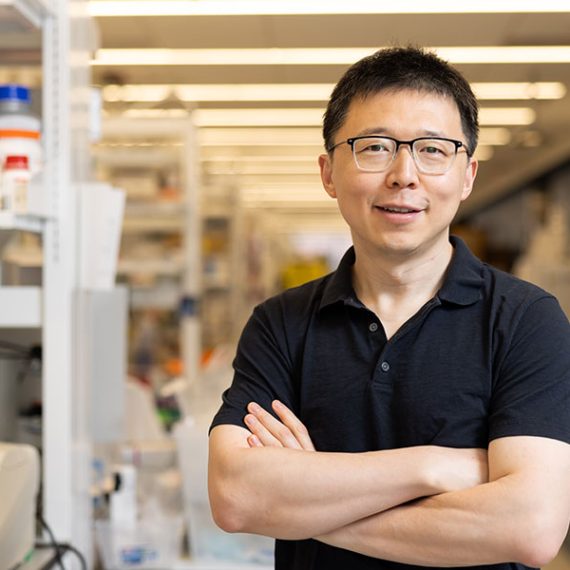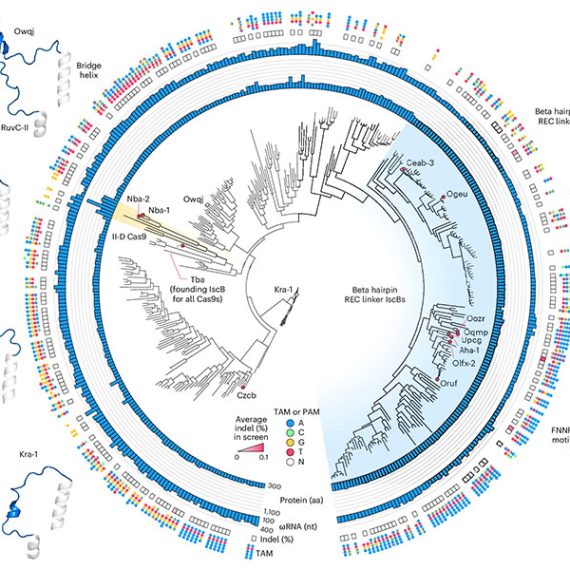Finding a way in
McGovern researchers are developing new ways to understand autism.

Our perception of the world arises within the brain, based on sensory information that is sometimes ambiguous, allowing more than one interpretation. Familiar demonstrations of this point include the famous Necker cube and the “duck-rabbit” drawing (right) in which two different interpretations flip back and forth over time.
Another example is binocular rivalry, in which the two eyes are presented with different images that are perceived in alternation. Several years ago, this phenomenon caught the eye of Caroline Robertson, who is now a Harvard Fellow working in the lab of McGovern Investigator Nancy Kanwisher. Back when she was a graduate student at Cambridge University, Robertson realized that binocular rivalry might be used to probe the basis of autism, among the most mysterious of all brain disorders.
Robertson’s idea was based on the hypothesis that autism involves an imbalance between excitation and inhibition within the brain. Although widely supported by indirect evidence, this has been very difficult to test directly in human patients. Robertson realized that binocular rivalry might provide a way to perform such a test. The perceptual switches that occur during rivalry are thought to involve competition between different groups of neurons in the visual cortex, each group reinforcing its own interpretation via excitatory connections while suppressing the alternative interpretation through inhibitory connections. Thus, if the balance is altered in the brains of people with autism, the frequency of switching might also be different, providing a simple and easily measurable marker of the disease state.
To test this idea, Robertson recruited adults with and without autism, and presented them with two distinct and differently colored images in each eye. As expected, their perceptions switched back and forth between the two images, with short periods of mixed perception in between. This was true for both groups, but when she measured the timing of these switches, Robertson found that individuals with autism do indeed see the world in a measurably different way than people without the disorder. Individuals with autism cycle between the left and right images more slowly, with the intervening periods of mixed perception lasting longer than in people without autism. The more severe their autistic symptoms, as determined by a standard clinical behavioral evaluation, the greater the difference.
Robertson had found a marker for autism that is more objective than current methods that involve one person assessing the behavior of another. The measure is immediate and relies on brain activity that happens automatically, without people thinking about it. “Sensation is a very simple place to probe,” she says.
A top-down approach
When she arrived in Kanwisher’s lab, Robertson wanted to use brain imaging to probe the basis for the perceptual phenomenon that she had discovered. With Kanwisher’s encouragement, she began by repeating the behavioral experiment with a new group of subjects, to check that her previous results were not a fluke. Having confirmed that the finding was real, she then scanned the subjects using an imaging method called Magnetic Resonance Spectroscopy (MRS), in which an MRI scanner is reprogrammed to measure concentrations of neurotransmitters and other chemicals in the brain. Kanwisher had never used MRS before, but when Robertson proposed the experiment, she was happy to try it. “Nancy’s the kind of mentor who could support the idea of using a new technique and guide me to approach it rigorously,” says Robertson.
For each of her subjects, Robertson scanned their brains to measure the amounts of two key neurotransmitters, glutamate, which is the main excitatory transmitter in the brain, and GABA, which is the main source of inhibition. When she compared the brain chemistry to the behavioral results in the binocular rivalry task, she saw something intriguing and unexpected. In people without autism, the amount of GABA in the visual cortex was correlated with the strength of the suppression, consistent with the idea that GABA enables signals from one eye to inhibit those from the other eye. But surprisingly, there was no such correlation in the autistic individuals—suggesting that GABA was somehow unable to exert its normal suppressive effect. It isn’t yet clear exactly what is going wrong in the brains of these subjects, but it’s an early flag, says Robertson. “The next step is figuring out which part of the pathway is disrupted.”
A bottom-up approach
Robertson’s approach starts from the top-down, working backward from a measurable behavior to look for brain differences, but it isn’t the only way in. Another approach is to start with genes that are linked to autism in humans, and to understand how they affect neurons and brain circuits. This is the bottom-up approach of McGovern Investigator Guoping Feng, who studies a gene called Shank3 that codes for a protein that helps build synapses, the connections through which neurons send signals to each other. Several years ago Feng knocked out Shank3 in mice, and found that the mice exhibited behaviors reminiscent of human autism, including repetitive grooming, anxiety, and impaired social interaction and motor control.
These earlier studies involved a variety of different mutations that disabled the Shank3 gene. But when postdoc Yang Zhou joined Feng’s lab, he brought a new perspective. Zhou had come from a medical background and wanted to do an experiment more directly connected to human disease. So he suggested making a mouse version of a Shank3 mutation seen in human patients, and testing its effects.
Zhou’s experiment would require precise editing of the mouse Shank3 gene, previously a difficult and time-consuming task. But help was at hand, in the form of a collaboration with McGovern Investigator Feng Zhang, a pioneer in the development of genome-editing methods.
Using Zhang’s techniques, Zhou was able to generate mice with two different mutations: one that had been linked to human autism, and another that had been discovered in a few patients with schizophrenia.
The researchers found that mice with the autism-related mutation exhibited behavioral changes at a young age that paralleled behaviors seen in children with autism. They also found early changes in synapses within a brain region called the striatum. In contrast, mice with the schizophrenia-related gene appeared normal until adolescence, and then began to exhibit changes in behavior and also changes in the prefrontal cortex, a brain region that is implicated in human schizophrenia. “The consequences of the two different Shank3 mutations were quite different in certain aspects, which was very surprising to us,” says Zhou.
The fact that different mutations in just one gene can produce such different results illustrates exactly how complex these neuropsychiatric disorders can be. “Not only do we need to study different genes, but we also have to understand different mutations and which brain regions have what defects,” says Feng, who received funding from the Poitras Center for Affective Disorders research and the Simons Center for the Social Brain. Robertson and Kanwisher were also supported by the Simons Center.
Surprising plasticity
The brain alterations that lead to autism are thought to arise early in development, long before the condition is diagnosed, raising concerns that it may be difficult to reverse the effects once the damage is done. With the Shank3 knockout mice, Feng and his team were able to approach this question in a new way, asking what would happen if the missing gene were to be restored in adulthood.
To find the answer, lab members Yuan Mei and Patricia Monteiro, along with Zhou, studied another strain of mice, in which the Shank3 gene was switched off but could be reactivated at any time by adding a drug to their diet. When adult mice were tested six weeks after the gene was switched back on, they no longer showed repetitive grooming behaviors, and they also showed normal levels of social interaction with other mice, despite having grown up without a functioning Shank3 gene. Examination of their brains confirmed that many of the synaptic alterations were also rescued when the gene was restored.
Not every symptom was reversed by this treatment; even after six weeks or more of restored Shank3 expression, the mice continued to show heightened anxiety and impaired motor control. But even these deficits could be prevented if the Shank3 gene was restored earlier in life, soon after birth.
The results are encouraging because they indicate a surprising degree of brain plasticity, persisting into adulthood. If the results can be extrapolated to human patients, they suggest that even in adulthood, autism may be at least partially reversible if the right treatment can be found. “This shows us the possibility,” says Zhou. “If we could somehow put back the gene in patients who are missing it, it could help improve their life quality.”
Converging paths
Robertson and Feng are approaching the challenge of autism from different starting points, but already there are signs of convergence. Feng is finding early signs that his Shank3 mutant mice may have an altered balance of inhibitory and excitatory circuits, consistent with what Robertson and Kanwisher have found in humans.
Feng is continuing to study these mice, and he also hopes to study the effects of a similar mutation in non-human primates, whose brains and behaviors are more similar to those of humans than rodents. Robertson, meanwhile, is planning to establish a version of the binocular rivalry test in animal models, where it is possible to alter the balance between inhibition and excitation experimentally (for example, via a genetic mutation or a drug treatment). If this leads to changes in binocular rivalry, it would strongly support the link to the perceptual changes seen in humans.
One challenge, says Robertson, will be to develop new methods to measure the perceptions of mice and other animals. “The mice can’t tell us what they are seeing,” she says. “But it would also be useful in humans, because it would allow us to study young children and patients who are non-verbal.”
A multi-pronged approach
The imbalance hypothesis is a promising lead, but no single explanation is likely to encompass all of autism, according to McGovern director Bob Desimone. “Autism is a notoriously heterogeneous condition,” he explains. “We need to try multiple approaches in order to maximize the chance of success.”
McGovern researchers are doing exactly that, with projects underway that range from scanning children to developing new molecular and microscopic methods for examining brain changes in animal disease models. Although genetic studies provide some of the strongest clues, Desimone notes that there is also evidence for environmental contributions to autism and other brain disorders. “One that’s especially interesting to us is a maternal infection and inflammation, which in mice at least can affect brain development in ways we’re only beginning to understand.”
The ultimate goal, says Desimone, is to connect the dots and to understand how these diverse human risk factors affect brain function. “Ultimately, we want to know what these different pathways have in common,” he says. “Then we can come up with rational strategies for the development of new treatments.”




